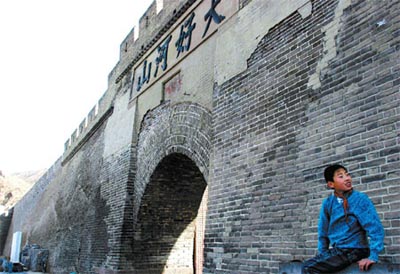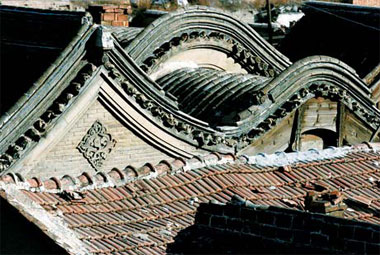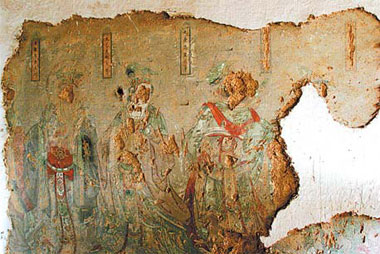Dajingmen, an ancient pass of the Great Wall, bears witness to the ups and downs of Zhangjiakou.
Few foreigners have heard of Zhangjiakou, an old foreign trade city in northern China, but the name Kalgan might ring a few bells for elderly Russians. Kalgan, in fact, is Zhangjiakou, a city located in the northwest of Hebei Province.
In the early 1900s, the inland city was all the rage. When a Russian businessman reached here, it meant that he had arrived in China.
To explore its history of trade, it is best to start off in Dajingmen, once an important pass on the Great Wall.
Built in 1458, Dajingmen was founded on the remains of the Great Wall, dating from the Northern Wei and Northern Qi (AD 386-577) dynasties. It was not only a military stronghold, but also an important pass for Han, Mongolian and Hui people to conduct trade and share culture.
As I stood at the 9-m-wide gate, the fierce wind made me feel like I could be blown away like an empty sack.
Meanwhile, a group of local elderly women started the yangge dance, beside the drab gate, for entertainment.
They dressed traditionally, in bright pinks and greens, but also wore fashionable items such as sunglasses and high-heeled shoes. Despite the cold, their dance made the nearly 600-year-old pass look lively.
I gathered my strength to reach a platform on the top of Dajingmen, from where I could see the city below me. On one side, the old town was in shades of gray; on the other side lies a new urban district where high-rise buildings have sprung up.
The platform's west brick wall collapsed in 1995 after heavy rainfall. It was rebuilt a year later but remained closed. The east section, which connects with the Great Wall, remains open to the public.
Another tourist attraction is Buzili, known as the birthplace of Zhangjiakou.
The 28-hectare town was founded in 1429, as a defense against the Mongolian cavalry from the north. This could explain why the castle-like compound initially had two doors - in the east and south. A smaller northern door was opened a century later, featuring 2-m-high roadblocks on either side, designed to stop the enemy's horses.
There are more than 10,000 residents in Buzili, with a large elderly population. Walking in the town was like entering a labyrinth. The narrow alleyways are so confusing that I would have got lost without a guide.
I was led to Yuhuangge, a Taoist temple worshiping the Jade Emperor, the supreme deity of Taoism.
After the founding of New China in 1949, the temple became a residential property, until a few years ago, when it was put under state protection.
Curving roofs of the old dwellings are bathed in the sunlight.
But renovations haven't started yet. The compound was desolate and full of broken bricks and timber. Still, in one of the rooms, visitors can find 400-year-old frescoes, which were discovered accidentally a few years ago.
The 6-sq-m colored paintings show the main figures of Taoism, but unfortunately the artworks were defaced.
"The former residents were afraid of being cursed, living in a temple which was supposed to be made for immortals," Liu Zhenying, a member of the Zhangjiakou Historical and Cultural Research Organization, explains. "They scratched the eyes and faces on the frescoes so the immortals were not able see them."
Some of the paintings' inlaid gold is also gone.
In spite of such severe damage, visitors can still see how graceful the paintings must have been.
"The only thing we can do to protect the temple is to lock it up, as we don't have enough money right now," Liu sighs.
As I walked through the ancient town, I stopped to admire the view of some old dwellings, featuring delicate brick carvings and elegant screen walls.
Traces of the city's past glory are still visible, such as the 400-year-old frescoes in a Taoist temple.
Iron-framed windows and doors, which are common in big cities to protect against burglars, can hardly be seen here. On the contrary, most dwellings are open to visitors.
The smoke of a coal stove on the roadside and many faded red slogans painted on the walls made me feel like I had ventured back into the 1960s.
"The local economy is behind other big cities and because of it the town is largely preserved," Liu says.
Buzili shifted from being a military town to a commercial county in the 1700s. Thousands of traders flocked from all over the country to conduct business.
"Only the richest businessmen could afford to build luxury houses inside the town at that time, while the others had to live outside. This is why Buzili is dotted with various old buildings of different styles, including Beijing traditional quadrangle dwellings, Shanxi-style ones and Anhui-style houses," Liu says.
Nowadays, these historical buildings are either occupied by locals, or used for social services.
Wenchangge, also called the Bell Tower by locals, is located in the town center.
It was amazing to see its Roman-style dome above the crossroads. "It shows that Zhangjiakou was influenced by Western culture long ago," Liu says.
Operating during the Ming and Qing dynasties (1368-1911), the Zhangjiakou-Kunlun ancient commercial route brought a great number of foreign traders to China.
The 4,000 km journey started from Dajingmen, through Kunlun in Mongolia, and ended in Charktu, Russia.
It reached its peak at the end of the Qing Dynasty (1644-1911), with an annual turnover of 150 million taels of silver, equal to 17 billion yuan ($2.3 billion). Due to the city's significant role in trading, the Zhangjiakou-Beijing railway was built in 1909.
The flourishing economy attracted 44 foreign banks from Germany, the United States, Japan and Britain, all of which established their own branches here. About eight of these buildings are still extant.
(China Daily November 22, 2007)





